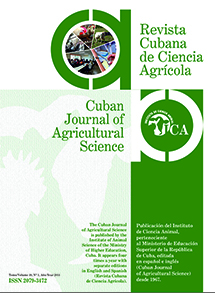Characterization of the floral structure and evaluation of seeds production from different materials of Tithonia diversifolia Hemsl.) A. Gray. in Cuba
Contenido principal del artículo
Resumen
In order to characterize the reproductive structure, the production and seed germination of different materials of Tithonia diversifolia Hemsl.) A. Gray, a total of three experiments were performed at different times and five plant materials were evaluated (3, 10, 16, 23, 25). The harvest of ten heads (2018 and 2019) was carried out by means of a random sampling at five points on the diagonal of the field. The evaluated materials constitute the treatments. A completely random design was used for the analysis of the variables diameter (cm) and seed heads weight (g), number and weight (mg) of full and empty seeds and of PGS seed heads-1. To the total number and the germination percentage of seed at different times 3, 5, 7 and 30 days) a simple classification nonparametric analysis of variance was performed. The studied materials showed phenotypic differences in terms of their reproductive structure. The seed heads of material 25 had a higher diameter. Material 16, due to its higher weight, distinguished itself from the rest of the evaluated materials. The waste from the seed heads is approximately 71.18 % of their total weight. The seed production of materials 10, 23 and 25 is very similar with respect to the total number of seeds in the seed heads, as well as the number of empty seeds. However, material 23 showed a lower number of full seeds (P ≤ 0.0005). These results contribute to the knowledge of the reproductive characteristics of each specific material, which will allow the development of future studies related to the gamic seed production strategy.
Key words: gamic seed, Tithonia, germination, inflorescences.
Key words: gamic seed, Tithonia, germination, inflorescences.
Detalles del artículo
Cómo citar
Rodríguez, I., Padilla, C., & Medina, Y. (2021). Characterization of the floral structure and evaluation of seeds production from different materials of Tithonia diversifolia Hemsl.) A. Gray. in Cuba. Cuban Journal of Agricultural Science, 55(4). Recuperado a partir de https://mail.cjascience.com/index.php/CJAS/article/view/1032
Sección
Ciencia de los pastos y otros cultivos
Aquellos autores/as que tengan publicaciones con esta revista, aceptan los términos siguientes:
- Los autores/as conservarán sus derechos de autor y garantizarán a la revista el derecho de primera publicación de su obra, el cuál estará simultáneamente sujeto a la Licencia Creative Commons Attribution-NonCommercial 4.0 International (CC BY-NC 4.0) que permite a terceros compartir la obra siempre que se indique su autor y su primera publicación esta revista. Bajo esta licencia el autor será libre de:
- Compartir — copiar y redistribuir el material en cualquier medio o formato
- Adaptar — remezclar, transformar y crear a partir del material
- El licenciador no puede revocar estas libertades mientras cumpla con los términos de la licencia
Bajo las siguientes condiciones:
- Reconocimiento — Debe reconocer adecuadamente la autoría, proporcionar un enlace a la licencia e indicar si se han realizado cambios. Puede hacerlo de cualquier manera razonable, pero no de una manera que sugiera que tiene el apoyo del licenciador o lo recibe por el uso que hace.
- NoComercial — No puede utilizar el material para una finalidad comercial.
- No hay restricciones adicionales — No puede aplicar términos legales o medidas tecnológicas que legalmente restrinjan realizar aquello que la licencia permite.
- Los autores/as podrán adoptar otros acuerdos de licencia no exclusiva de distribución de la versión de la obra publicada (p. ej.: depositarla en un archivo telemático institucional o publicarla en un volumen monográfico) siempre que se indique la publicación inicial en esta revista.
- Se permite y recomienda a los autores/as difundir su obra a través de Internet (p. ej.: en archivos telemáticos institucionales o en su página web) antes y durante el proceso de envío, lo cual puede producir intercambios interesantes y aumentar las citas de la obra publicada. (Véase El efecto del acceso abierto).
